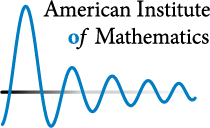
at the
American Institute of Mathematics, San Jose, California
organized by
Mimi Dai, Adam Larios, Alexis F Vasseur, and Kazuo Yamazaki
This workshop, sponsored by AIM and the NSF, is focused on cutting edge ideas currently emerging in the theory of fluid dynamics. The mathematical analysis of partial differential equations in fluid mechanics have seen remarkable progress in the last few decades. In its study, "criticality" plays a crucial role in various ways: exponents of the fractional Laplacian in the diffusion above which global well-posedness may be proven; exponents of the initial regularity space above which local well-posedness has been verified, and similarly spatial dimension below which local well-posedness is known; etc. On the other hand, "stochasticity" plays a crucial role in investigation of turbulence, and it has been well documented in recent works that random noise can possess regularizing effects. Below, we describe several convergent areas of emerging research related to the areas of criticality and stochasticity.
Stochastic Part of the workshop
The research direction on the stochastic partial differnetial equations (PDEs) of fluids has seen remarkable progress in recent years. Efforts to extend the technique of convex integration to stochastic PDEs has started only in the past several years, and in particular, the non-uniqueness in law of the three-dimensional stochastic Navier-Stokes equations at the level of probabilistically-strong solutions was successfully shown. Nonetheless, various problems remain; e.g., currently, the types of random noise with which one can prove such non-uniqueness is very limited. On the other hand, there is a growing body of evidence that noise can somehow regularize the solution and thereby induce global well-posedness. Finally, the research direction on singular stochastic PDEs has seen tremendous advances in the past decade with the inventions and extensions of rough path theory, the theory of regularity structures, and the theory of paracontrolled distributions to prove well-posedness of such PDEs which consist of non-linear terms that are classically ill-defined. It is of great interest if one can make connections among new results from these research directions.
Criticality of Singularity Formation
The Euler system of PDEs for incompressible ideal fluids is one of the oldest partial differential equations to be written down. Despite its relatively simple form, it is a very accurate model to describe the dynamics of inviscid incompressible flows. However, the mathematical structure of its solutions is still very mysterious. Recently, several stunning results have emerged, challenging classical mathematical perceptions of the model. For instance, the convex integration method produces infinitely many solutions to the Cauchy problem jeopardizing hopes of proving well-posedness. Finite time blow-ups solutions with certain Holder-class initial values have been exhibited, showing pathologies of the equation even for classical solutions. Moreover, it has been shown that some of these surprising behaviors are closely related to turbulence, as demonstrated by the recent proof of the Onsager conjecture. A part of the workshop will be dedicated to study some of the consequences of these new results. The following problems may be considered during the workshop:
Numerical/Computational
Numerical and computational studies are not only of practical importance, but they can also shed light on theoretical questions. By the same token, theoretical developements often drive advancements in numerical and computational capabilities. The very first civilian applications of computers were simulations of problems in fluid dynamics, and to this day, developing faster, more reliable, and more accurate techniques for solving fluid equations remains a challenging major area within scientific computing. Recently, there have been several promising new research directions aimed at investigating the possibility of singularity formation in the Navier-Stokes equations. Along these lines, in the workshop, we will consider the following problems:
This event will be run as an AIM-style workshop. Participants will be invited to suggest open problems and questions before the workshop begins, and these will be posted on the workshop website. These include specific problems on which there is hope of making some progress during the workshop, as well as more ambitious problems which may influence the future activity of the field. Lectures at the workshop will be focused on familiarizing the participants with the background material leading up to specific problems, and the schedule will include discussion and parallel working sessions.
The deadline to apply for support to participate in this workshop has passed.
For more information email workshops@aimath.org
Plain text announcement or brief announcement.
Go to the
American Institute of Mathematics.
Go to the
list of upcoming workshops.